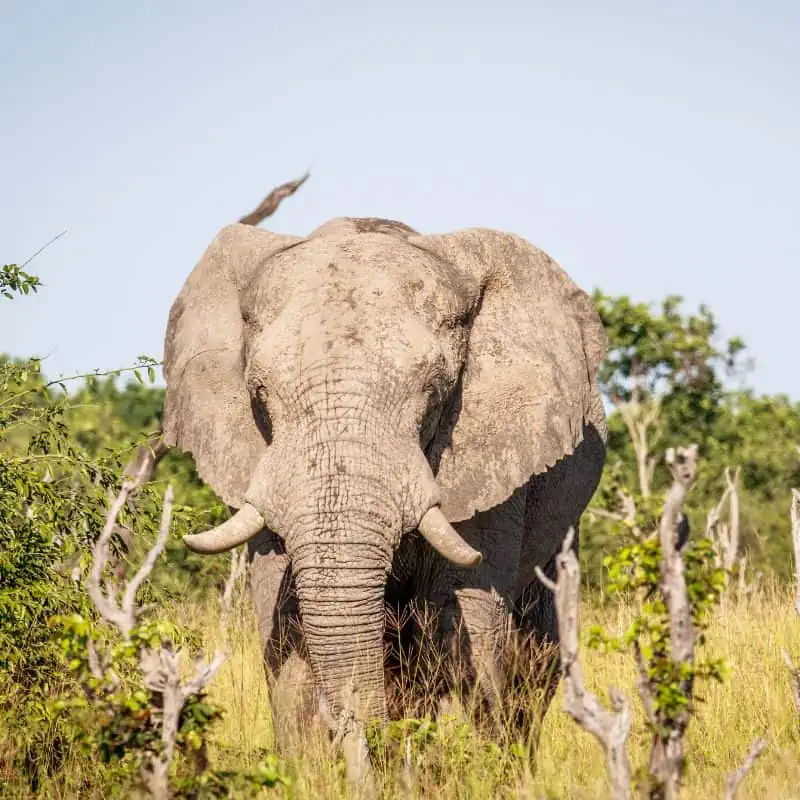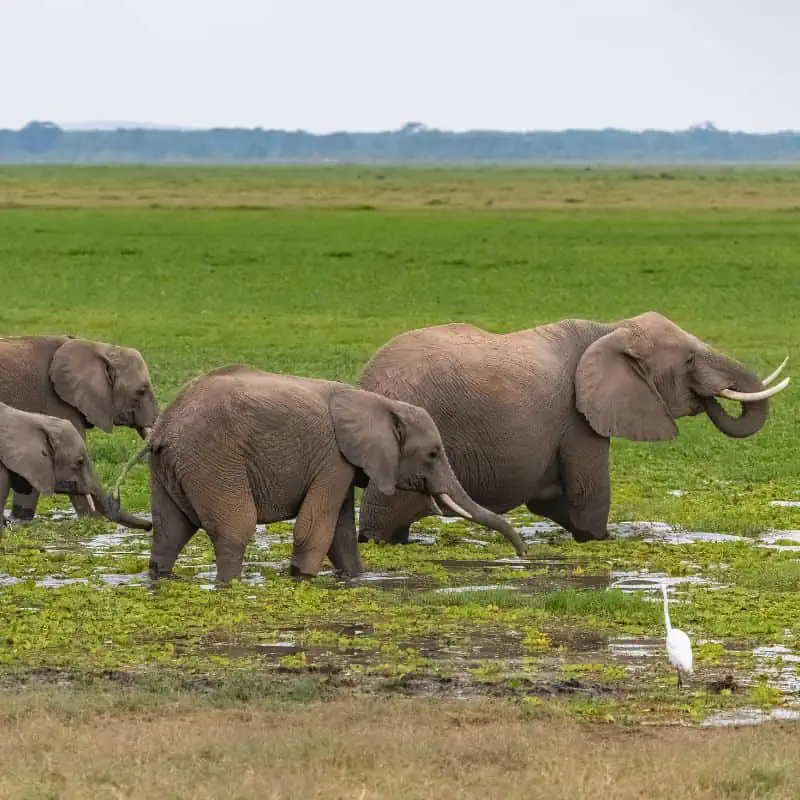Elephants are versatile species that used to be found in the frozen lakes in the Arctic to the sandy pits of sub-Saharan Africa. These magnificent creatures are essential for the conservation of an ecosystem. So, they reside in multiple habitats and a list of countries worldwide.
Elephants are adaptable creatures found in the wild in Africa and Asia. They are mainly found in forests, grasslands, and savannas, but the list continues beyond here. They occupy deserts, swamps, and wetlands in tropical and subtropical regions in Africa and Asia.
Everything about elephants is nothing short of magnificent, but the sheer range of habitats they adapt to is another part of their magnificence. This article will elaborate on the number of habitats elephants live in and what particular species you’ll find there.

5 Different Terrains Elephants Occupy
Elephants occupy many different terrains with specific characteristics. Each landscape is occupied by a particular type or subspecies of an elephant.
Let us tell you about these terrains and what subspecies of elephants are in that terrain.
1. Savannas
A savanna is a tropical or subtropical grassland usually found in eastern Africa, with a few scattered trees. Savannas usually stay extremely warm throughout the year, which makes them an excellent place for elephants.
So much so that the Loxodonta Africana, also known as the African savanna elephant, got its common name with the help of the terrain they are most fond of.
Elephants in the African savanna favor wide-open grasslands, with abundant foraging possibilities that help them meet their nutritional needs.

2. Rainforests
While the bigger savanna elephants occupy the African savannas, scientists have figured out that the rainforests of west and central Africa are inhabited by the smaller cousins of savanna elephants known as the African forest elephants.
African forest elephants prefer dense rainforests and woodlands. Over the years, they have adapted to living in the rainforest.
They are smaller in size so that they can move around quickly in the forest, and their tusks are smaller, so they don’t get caught in the undergrowth in the woods.
3. Desert
It may seem absurd, but elephants can adapt to wherever they live, including deserts. Elephants can also be found in deserts, although in a much less population than in savannas and rainforests.
Elephants that live in northernmost Africa are found in Mali’s Sahel Desert. In quest of water, the small, nomadic herd of Mali elephants travels in a circle over the desert.
Another important factor contributing to the absence of elephants from dry areas is the absence of water.

4. Grasslands
In case you’re wondering, grasslands are different from savannas. Grasslands consist of only grass, whereas savannas support trees as well.
Asian elephants are fond of grasslands and are usually found in the grassy plains of thirteen countries in South and Southeast Asia.
Historically, elephants have preferred plants as their food, but as time has passed, Asian elephants have adapted to the grasslands of Asia.
5. Other Terrains Elephants Are Found
Understanding the magnificence of elephants starts with appreciating how diverse their habitats are. Apart from the four main terrains they are found in, there are other areas they thrive in.
Asian elephants can inhabit the moist deciduous forests of India. These forests receive an annual rainfall of 100-200 cm.
Indian elephants are found in dry-thorn forests as well. These dry thorn forests are located in the country’s various states, such as Gujarat, Uttar Pradesh, Rajasthan, and Madhya Pradesh.
Some African elephants also inhabit swamp lands, highlands, and subtropical regions.

Countries Where You Can Find Elephants
Researchers estimate that elephants currently roam and inhabit approximately 50 countries in Asia and Africa. Of these 50 countries, 37 are found in Africa, whereas 13 are in South and Southeast Asia.
African Savanna Elephant
African savanna elephants are found in 37 African nations.
The list of these countries includes; Angola, Benin, Botswana, Burkina Faso, Cameroon, Central African Republic, Chad, Congo, DR Congo, Cote d’Ivoire, Equatorial Guinea, Eritrea, Eswatini, Ethiopia, Gabon, Ghana, Guinea, Guinea-Bissau, Kenya, Liberia, Malawi, Mali, Mozambique, Namibia, Niger, Nigeria, Rwanda, Senegal, Sierra Leone, Somalia, South Africa, South Sudan, Tanzania, Togo, Uganda, Zambia, Zimbabwe.
Botswana currently has the largest elephant population in the country, estimated at 130,000 elephants in the wild.
The elephant population in Botswana is increasing despite the population of elephants decreasing in various other parts of the world.
Savanna elephants are well-adjusted to countries such as Botswana, Namibia, and Angola owing to the number of savannas present there.
That is a significant reason why elephant populations thrive here.
African Forest Elephants
African forest elephants are present in fewer countries than the Savanna elephant. The total forest elephant population is also less than the savanna elephant.
African forest elephants are found in Gabon, Cameroon, the Central African Republic, Ghana, and the Republic of Congo.
Among these countries, the largest forest elephants are in Gabon and the Congo.
Despite covering only 13% of central Africa’s forest area, Gabon still has the highest population of African forest elephants.
Gabon is home to an estimated 60-70% of the total forest elephant population, with approximately 90,000 elephants.
Asian Elephants
Asian elephants are found in 13 countries. These countries include the likes of Thailand, Malaysia, Bangladesh, Sri Lanka, and India.
The total population of Asian elephants has radically decreased due to poaching and habitat destruction.
India is the host to the largest population of wild Asian elephants. Approximately more than 50% of Asian elephants are found in India.
The South and North East parts of India currently host the largest of the estimated 27,000 wild elephants in India.
Despite being a small island, Sri Lanka has the second-largest Asian elephant population. The wildlife department of Sri Lanka estimates that the country currently has 7000 elephants in the wild.
Final Thoughts About Where Elephants Live
You can usually find Elephants in Asia and Africa.
Elephants are fascinating, from their enormous size to their ability to adapt to just about any terrain around the globe.
An elephant never ceases to amaze.
FAQs
Are Elephants Found on All Continents?
Elephants are only present in their native continents. Elephants disappeared from Europe after the end of the Roman empire. Australia, North America, and South America have captive elephants, but none in the wild.
How Can Elephants Survive in Different Terrains?
Evolution has also made it easy for them to survive in different types of terrains over the centuries they have lived. Elephants have the advantage of having a large body size which they use to adapt to their habitat.
How Have Elephants Adapted Themselves to Live in a Desert?
Over the centuries that elephants have survived, they have adapted their bodies to stay in the desert. Those in deserts have a larger footprint, helping keep feet from sinking into the sand. They can also survive without drinking water for several days and only eating vegetation that grows in riverbeds.
